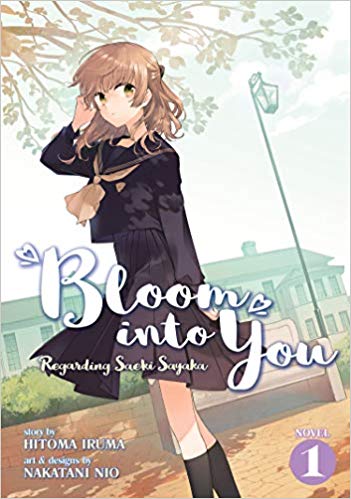By Hitomi Iruma and Nakatani Nio. Released in Japan as “Yagate Kimi ni Naru: Saeki Sayaka ni Tsuite” by Dengeki Bunko. Released in North America by Seven Seas. Translated by Jan Cash and Vincent Castaneda. Adapted by Jenny McKeon.
Bloom Into You is one of the bigger runaway yuri hits of the past few years, so the fact that it’s getting a series of light novel side-stories, particularly given it’s by the prolific Hitomi Iruma, author of Adachi and Shimamura (also coming soon from Seven Seas) should not really surprise me. But I admit I am surprised. Every time there’s a shift in the marketplace I always seem to be blown away. All the old chestnuts: “yuri won’t sell”, “light novels won’t sell”, “tie-in novels never get licensed” – all these are long since dead. Seriously, appreciate the market we live in now. You should especially appreciate it because it gives us this, the first in a projected three-volume series of novels about Sayaka, Touko’s best friend and winner of the “I absolutely want to read more about her” poll that I’m sure was taken internally at ASCII Mediaworks. This book serves as a prequel to the manga, showing us Sayaka’s early life – and, more importantly, her inner monologue.
The book is divided into two sections. The first introduces us to Sayaka at 11 years old, busily taking part in endless activities and trying to give off the impression of being a mature, serious person – even to herself. Her swimming lessons are part of this, but are broken up every time by an unnamed girl (I called her Uruka after a while, after the BokuBen girl with similar looks and personality) who wants to be Sayaka’s friend and find out more about her… and also about the heat that she feels within her body whenever she’s around Sayaka. This story was bittersweet and painful, ending with Sayaka literally fleeing the scene but also learning more about herself. The second, longer story takes place when Sayaka is 14 or so, and is about her relationship – touched in the manga – with her sempai (who does have a name, but Sayaka chooses to stick with sempai even when they are dating.) Sayaka does not initiate this affair, but certainly is the most deeply affected by it, something she slowly goes to realize as time passes.
The best reason to get this is Sayaka, who is captured perfectly here, showing off a serious, mature for her age girl who nevertheless still has a great deal of growing up and discovery to do about herself. We see this captured in the stories, as the reader is usually well ahead of her in terms of what’s actually happening in the other character’s heads – Sayaka has trouble figuring out what the other girl is thinking, but we do not. Frequently this an be, as I noted, very painful – seeing swimming girl’s nascent excitement and frustration around Sayaka is very identifiable, and I was upset as it became clear that, as this book is from Sayaka’s POV, we’d never find out what happened to her after the story. As for Yuzuki, Sayaka’s senpai, it’s clear to the reader almost immediate that she’s in love with the idea of a love affair more than anything about Sayaka herself. Still, she’s not a pure villain in this book, and her awkward “oh crap what have I done” moments are also squirm-inducing.
The book closes with Sayaka determined to move on and never fall in love again, a determination that doesn’t even last five minutes into high school as she meets Touko and is shot through the heart. The second book promises to show us Sayaka’s POV of events during the manga proper. Till then, this is essential for Bloom Into You fans, as well as anyone who likes well-told coming of age stories.

As i was reading this it struck me how similar it felt to Marimite. Saeki is probably a bit too stuck up to be anyone’s petite sœur but the attention to the mundane and internal monologue were reminiscent. I wouldn’t have thought the rival love interest/best friend character would have garnered enough interest to fill three volumes of backstory, but i’m glad there is. And you’re right, fifteen years ago we couldn’t have imagined something of this caliber making it to print in the West. It’s quite wonderful.